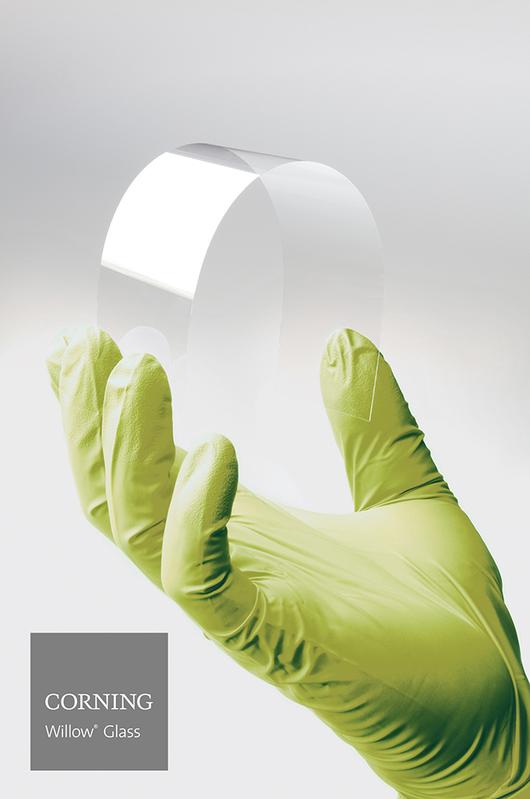Glass meets Flexibility

Corning® Willow™ Glass Bend © Corning Incorporated
Flexible glass, such as ultra-slim Corning® Willow® Glass, produced at thicknesses of 100 micron and 200 micron has the ability to bend, while maintaining perfect barrier properties, superior surface quality, greater transparency, and high temperature processing, outperforming polymers. At the same time it has the potential to be used in roll-to-roll large area processing. These qualities make flexible glass an outstanding material for displays, touch panels, thin-film batteries and Photovoltaic (PV) products. According to Frost & Sullivan’s report »Innovations in Encapsulation Technologies for Printed Electronics (Technical Insights), D513-TI«, flexible glass poses tough competitions to polymer-based solutions.
Fraunhofer FEP aims to advance processing and handling of flexible glass. Fraunhofer FEP and Corning are working together to promote functionality of a glass surface using PVD deposition methods to facilitate device processing; remaining aware of the thermal and size parameters of the coated substrate, and the effects they could have on device fabrication.
During her presentation, Dr. Junghaehnel will focus on optimization of the magnetron sputtering process for low-stress deposition and emphasize the impact of selected process parameters during high-deposition sputtering of selected materials on the stress of a substrate. These results have been compared with investigations on flexible PET substrates. The determined parameters will be a starting point to improve handling and performance of flexible glass in existing thin-film coating equipment. Fraunhofer FEP’s thin-film coating equipment is suitable for substrates up to 200 mm in width and will be developed for roll-to-roll, high-rate deposition coating of flexible glass.
About Fraunhofer FEP
Fraunhofer FEP (www.fep.fraunhofer.de) is one of 67 institutes of the Fraunhofer-Gesellschaft, Europe’s largest applied research organization. For more than 20 years we have been active in vacuum coating technology, electron beam surface modification processes, and electron beam source development. In these core areas we work on enhancing technologies, processes and key components. With our coatings we refine products in the area of electronics, sensor, optics, mechanical engineering, packaging, energy, environment, biomedical engineering, architecture, preservation and agriculture.
About Corning Incorporated
Corning Incorporated (www.corning.com) is the world leader in specialty glass and ceramics. Drawing on more than 160 years of materials science and process engineering knowledge, Corning creates and makes keystone components that enable high-technology systems for consumer electronics, mobile emissions control, telecommunications and life sciences. Our products include glass substrates for LCD televisions, computer monitors and laptops; ceramic substrates and filters for mobile emission control systems; optical fiber, cable, hardware & equipment for telecommunications networks; optical biosensors for drug discovery; and other advanced optics and specialty glass solutions for a number of industries including semiconductor, aerospace, defense, astronomy, and metrology.
Media Relations Contact Fraunhofer FEP:
Annett Arnold, M. Sc. | Phone +49 351 2586-452 | annett.arnold@fep.fraunhofer.de
Media Relations Contact Corning:
John O‘Hare | Phone +1 607 974-7488 | ohareja@corning.com
Investor Relations Contact Corning:
Ann H.S. Nicholson | Phone +1 607 974-6716 | nicholsoas@corning.com
Scientific contact:
Dr. Manuela Junghähnel | Phone +49 351 2586-128 l manuela.junghaehnel@fep.fraunhofer.de
Media Contact
All latest news from the category: Materials Sciences
Materials management deals with the research, development, manufacturing and processing of raw and industrial materials. Key aspects here are biological and medical issues, which play an increasingly important role in this field.
innovations-report offers in-depth articles related to the development and application of materials and the structure and properties of new materials.
Newest articles

A universal framework for spatial biology
SpatialData is a freely accessible tool to unify and integrate data from different omics technologies accounting for spatial information, which can provide holistic insights into health and disease. Biological processes…

How complex biological processes arise
A $20 million grant from the U.S. National Science Foundation (NSF) will support the establishment and operation of the National Synthesis Center for Emergence in the Molecular and Cellular Sciences (NCEMS) at…

Airborne single-photon lidar system achieves high-resolution 3D imaging
Compact, low-power system opens doors for photon-efficient drone and satellite-based environmental monitoring and mapping. Researchers have developed a compact and lightweight single-photon airborne lidar system that can acquire high-resolution 3D…





















